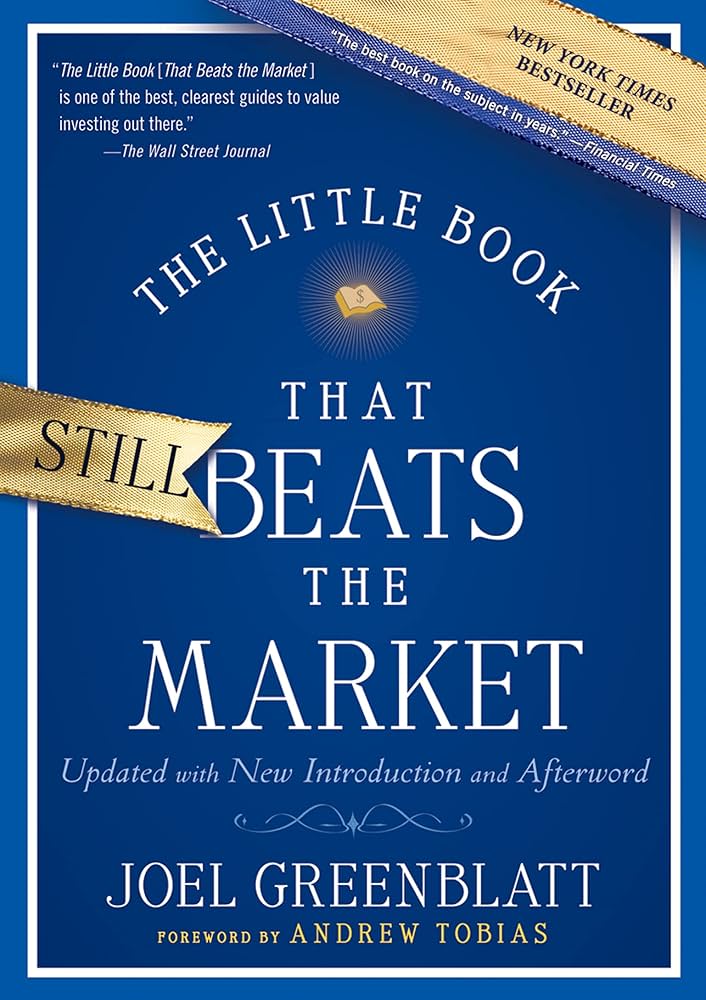Introduction to The Little Book That Beats The Market
Joel Greenblatt’s The Little Book That Beats The Market presents a compelling value investing strategy called the “Magic Formula” that claims to outperform the market by a wide margin. This 150-page book, which can be read in a single sitting, distills complex investment concepts into an approachable system that even beginners can implement. Greenblatt, a successful hedge fund manager who achieved 30% annual returns at Gotham Capital, argues that most investors have no business picking individual stocks without a systematic approach. His solution? A quantitative method combining two key financial metrics that historically delivered 30.8% annual returns compared to the market’s 12.3% during his 17-year backtest period.
Key Takeaways from The Little Book
1. Market Volatility Creates Opportunities
Greenblatt demonstrates how stock prices often swing wildly without corresponding changes in business fundamentals. For example:
- Amazon’s stock price fluctuated between $1,377 and $2,012 (50% difference) while its business value remained relatively stable
- Gap’s shares ranged from $18 to $31 (70% difference) without dramatic changes in clothing sales
This volatility creates opportunities to buy quality businesses at discounted prices when the market overreacts to short-term information.
2. The Challenge of Business Valuation
Determining a company’s intrinsic value is complex because it requires estimating:
- Future earnings potential
- Confidence in those predictions
- Long-term (5-10 year) growth prospects
Greenblatt acknowledges this difficulty but provides a systematic way to identify undervalued companies.
3. The Two Key Metrics: Earnings Yield and Return on Capital
The Magic Formula combines two fundamental measures:
| Metric | Calculation | What It Measures |
|---|---|---|
| Earnings Yield | EPS / Stock Price | How cheap the stock is relative to earnings |
| Return on Capital | Net Income / Total Capital | How efficiently the business generates profits |
The strategy seeks companies with both high earnings yield (low price) and high return on capital (quality business).
The Magic Formula Investing Strategy
How the Formula Works
Greenblatt’s system ranks all stocks by:
- Creating a list ranked by return on capital (highest to lowest)
- Creating a separate list ranked by earnings yield (highest to lowest)
- Combining the rankings to find stocks with the best combination of both metrics
Historical Performance
During Greenblatt’s 17-year backtest (1988-2004):
- Magic Formula returned 30.8% annually vs. 12.3% for the market
- $10,000 grew to nearly $1 million vs. $70,000 in the S&P 500
- Outperformed in 100% of rolling 3-year periods
Step-by-Step Implementation
To implement the Magic Formula:
- Visit magicformulainvesting.com
- Select companies with market caps >$50 million
- Buy 5-7 top-ranked stocks (20-33% of intended capital)
- Repeat every 2-3 months until fully invested (20-30 stocks total)
- Hold each stock for exactly 1 year (sell losers a few days early, winners a few days late for tax benefits)
- Reinvest proceeds in new Magic Formula stocks
Critical Analysis: Pros and Cons
Strengths of the Magic Formula
- Simple yet powerful: Focuses on just two key metrics
- Systematic approach: Removes emotion from investing
- Quality + value: Combines best of both investment philosophies
- Strong historical returns: Demonstrated outperformance
Potential Limitations
- Periods of underperformance: Can trail the market for months or even years
- Limited backtesting: Primarily tested on 1988-2004 data
- Ignores balance sheet: Doesn’t account for debt levels
- Requires discipline: Many investors abandon the strategy during drawdowns
“The secret sauce to this magic formula is not in the formula itself but the belief in the system.” – Joel Greenblatt
Is The Magic Formula Still Relevant Today?
While the core principles remain sound, investors should consider:
- The formula’s performance in recent years has been mixed according to various analyses
- Modern markets may require adjustments to the original criteria
- Technology and quantitative investing have become more sophisticated since the book’s publication
That said, the fundamental concept of buying quality businesses at bargain prices remains a timeless investment principle.
Final Verdict: Who Should Read This Book?
Best for: Beginner to intermediate investors looking for a systematic approach to value investing. The book’s simplicity and humor make it highly accessible. Not ideal for: Investors who prefer deep fundamental analysis or those unwilling to stick with a strategy through periods of underperformance. While the Magic Formula isn’t a guaranteed path to riches, it provides a disciplined framework that helps investors avoid common pitfalls. As Greenblatt emphasizes, the real challenge isn’t finding the strategy – it’s having the patience and conviction to follow it consistently.
